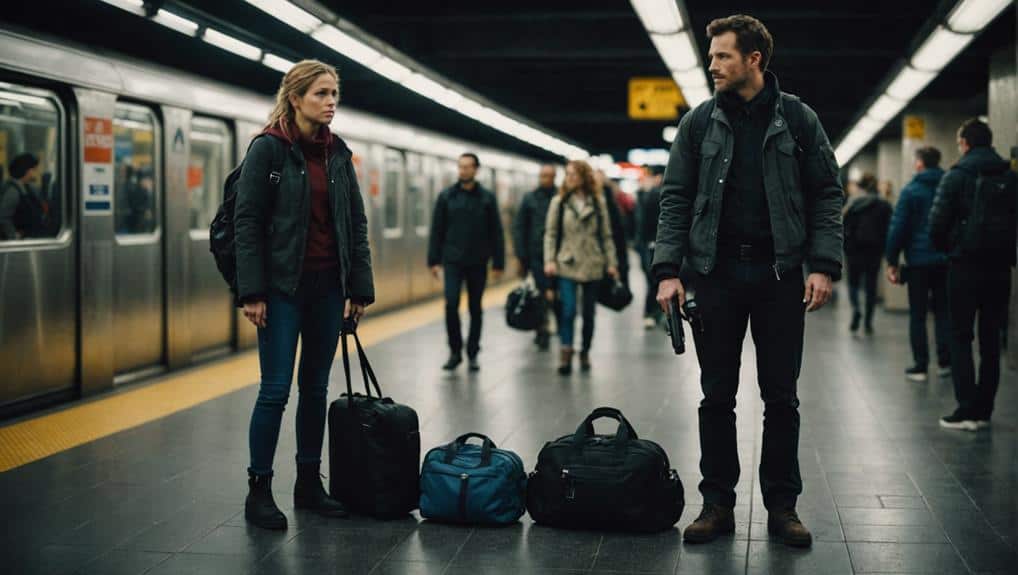Hey there, public transport warrior! Ready to supercharge your commute with
self-defense gear that keeps you safe and confident? Trust me, it’s all about being prepared. Picture carrying a
discreet self-defense keychain, a small but mighty pepper spray, or even a loud
personal alarm to scare off any troublemakers. Don’t forget, staying aware and choosing well-lit spots can make a world of difference. And—check this out—knowing the ins and outs of
local laws for these tools means you won’t just be safe, you’ll be smart about it too. There’s way more to this than meets the eye!
Pre-planning and Preparedness
When it comes to
commuting safely on public transportation,
pre-planning and preparedness are essential. You’ll want to
research your routes, stops, and schedules to avoid unfamiliar or potentially unsafe areas. Imagine gliding through your commute with confidence, knowing exactly where you’re headed. It’s like laying out a treasure map, minus the pirates.
Don’t forget to
notify a trusted friend or family member about your travel plans. Share your expected arrival times so someone knows if things go sideways. Think of it like having a
personal safety net, ready to catch you if you fall.
Understanding the locations of
emergency exits, alarms, and
first aid kits is vital. Picture yourself on a bus or train, and you know where everything is—like a superhero with a mental map of escape routes. Regularly review emergency procedures, so you’re ready to act quickly if needed.
Proactive planning isn’t just smart—it’s empowering. It helps you handle potential risks and makes commuting less stressful. Plus, carrying some
self-defense tools can add an extra layer of security. With the right preparation, you can transform your daily commute into a safer, more confident journey.
Key Safety Measures
After laying the groundwork with thorough pre-planning and preparedness, it’s time to focus on
key safety measures that can make a real difference during your commute. First, always choose
well-lit and visible seating areas. Sitting in an open, well-lit spot makes you less of a target for thieves or harassers since others can easily see you. Plus, it increases the chance that someone will step in if something goes wrong. Carrying a
Panic alarm can also help by drawing attention quickly in case of emergencies.
Next,
stay aware of your surroundings. It’s tempting to immerse yourself in your favorite playlist or scroll through social media, but staying alert helps you notice unusual behaviors.
Trust your instincts—if something feels off, it probably is. Don’t hesitate to move or seek help.
Maintaining
personal space is another critical safety measure. Keeping a respectful distance from others not only respects boundaries but also discourages unwanted attention. And let’s talk about keeping your
valuables secure. Use zipped bags or hard-to-reach pockets to lower your risk of
pickpocketing.
Lastly, trust your instincts. If you feel uncomfortable or threatened, don’t be shy about asking for help from fellow passengers or transport staff. Your
personal protection is paramount, so take these steps seriously to stay safe.
Potential Hazards
Maneuvering the world of
public transportation brings its own set of
potential hazards that you need to be aware of.
Crowded buses and trains are hotspots for
pickpockets, so keep your valuables in zipped bags or hard-to-reach pockets. It’s also a good idea to be
watchful of your surroundings, especially in packed areas.
Harassment incidents are, unfortunately, common in these settings. Trust your instincts. If something feels off, don’t hesitate to seek help from fellow commuters or transport staff. According to surveys, over 40% of public transport users have faced unwanted attention. This makes it vital to have a plan. Carrying
personal alarms or
pepper spray can give you a sense of security. These tools are handy to ward off potential aggressors who might feel emboldened by the anonymity of a crowd.
Nearly 25% of commuters report feeling unsafe during their travels. This highlights the importance of being prepared. Familiarize yourself with
self-defense skills, just in case you need them. Your commute shouldn’t be a source of stress; being aware of these potential hazards and taking proactive steps can make all the difference.
Handling Emergencies
Despite the best precautions, emergencies can still arise on public transportation. Staying calm and alert during these situations is vital. Panic can cloud your judgment and lead to unsafe decisions. Familiarizing yourself with emergency exits, alarms, and communication points on public transport guarantees you can quickly navigate to safety if needed. Having
safety tools like pepper sprays can also prepare you for unexpected threats.
Listening for announcements and following instructions from transport staff helps maintain order and facilitates timely evacuations. Remember, emergency communication systems are there for your safety. They allow you to report suspicious behavior or emergencies directly to authorities, enhancing overall safety and security.
Security cameras, increasingly installed in public transport systems, act as a deterrent to crime and provide valuable evidence during emergencies. Knowing their presence can offer some peace of mind.
Here’s a quick checklist to help you prepare:
- Know the location of emergency exits.
- Identify communication points and alarms.
- Stay calm and listen for announcements.
- Report suspicious activities using emergency communication systems.
- Trust in the deterrent effect of security cameras.
In case of an emergency, having safety tools like stun guns or pepper sprays can provide an added layer of personal security. Stay vigilant and prepared, and remember, your safety and security come first.
Self-Defense Tools
When you’re on public transportation, having the right
self-defense tools can make all the difference. From
stun guns that zap attackers to pepper spray that blinds them, these gadgets are essential for your safety, but you need to know what’s legal in your area. Imagine pulling out a tactical flashlight that not only lights your path but can shatter glass if needed—pretty cool, right? Additionally, consider carrying a
door stop alarm for when you’re staying in unfamiliar places; its 120dB alarm can deter intruders effectively
Essential Self-Defense Tools
Maneuvering public transportation can sometimes feel intimidating, but equipping yourself with essential self-defense tools can greatly enhance your personal safety. Imagine waiting for a bus late at night, and suddenly you feel uneasy. Having a self-defense tool on hand gives you peace of mind and a sense of control.
- Stun guns: These pack a punch with an electric shock, incapacitating attackers and giving you time to escape. Consider options like the Fang Keychain Stun Gun which also includes a flashlight.
- Pepper spray: A classic choice that blinds and disorients, it’s lightweight and easy to carry for self-defense.
- Personal alarm: Attach this to your keychain, and with one press, it emits a deafening sound to attract attention and scare off threats.
- Expandable batons: Hidden in plain sight, these can be swiftly deployed to keep attackers at bay.
- Self-defense keychains: Discreet and practical, they blend in with your daily items but pack a powerful punch when needed.
Imagine pulling out your pepper spray, ready to defend yourself if someone gets too close. Or, imagine the peace that comes from knowing a loud personal alarm is just a button press away. Equip yourself, stay vigilant, and make your commute safer
Legal Considerations
Maneuvering the
legal landscape of
self-defense tools is just as crucial as knowing how to use them. Carrying items like stun guns or pepper spray can be a lifesaver, but you’ve got to
check if they’re legal in your area first. Nothing’s worse than feeling safe only to find out you’re
breaking the law. Different places have
rules about the size, type, and use of self-defense weapons, so do your homework to guarantee your safety legally.
Imagine defending yourself on a crowded bus only to face assault charges because someone thought you went overboard. It’s a nightmare, right?
Understanding when and how to use your self-defense tools can help you avoid this. If something goes down,
witness testimonies and quick reporting can be your best friends. They can make all the difference in legal outcomes, so document everything you can.
Know your rights; it’s crucial. Misinterpreting them can turn you from defender to defendant faster than you think. Keep your cool, stay informed, and make sure you’re not just safe but also on the right side of the law. After all, the best defense is a smart defense!
Legal Considerations
Before you grab that pepper spray or stun gun for your commute, remember that carrying
self-defense gear can get tricky with
local laws. You’ll need to check the rules where you live to avoid any legal mess, and trust me, you don’t want to end up on the wrong side of that. If you ever have to use your gear, make sure to report the incident right away, as having witnesses and proper documentation can be a lifesaver in any
legal situation.
Weapon Carrying Laws
When considering carrying
self-defense gear on public transportation, it’s crucial to understand the
legal landscape surrounding such items. Maneuvering
weapon carrying laws can be tricky, and the consequences of not doing your homework can be severe. Imagine getting fined or even jailed just because you didn’t check the
local regulations! For instance,
Mace Pepper Spray is generally legal for self-defense, but state regulations can vary greatly.
First, remember that carrying
stun guns or pepper spray isn’t universally accepted. Some places treat stun guns like non-lethal weapons, but others might restrict or require
permits for them. Pepper spray? Sure, it’s commonly allowed, but its size, strength, and usage might be tightly controlled.
Concealed carry of items like knives and batons usually demands permits and specific training. Violating these rules can lead to
hefty fines or even imprisonment. So, always do your research before deciding what self-defense tools to carry.
Here’s a quick list to keep in mind:
- Verify local regulations before carrying any self-defense gear.
- Check if your stun gun needs a permit.
- Understand size and strength limitations for pepper spray.
- Know the training requirements for concealed weapons.
- Be aware of the legal repercussions for non-compliance.
Stay informed and you’ll commute safely and legally.
Reporting Self-Defense Incidents
After ensuring you’re abiding by local weapon carrying laws, it’s just as important to know how to report any
self-defense incidents. Imagine this: you’ve just defended yourself on a crowded bus, adrenaline pumping, everyone staring. Your next move? Reporting the incident. It’s vital to contact
local authorities right away. Early reports can greatly influence the outcome of any
legal disputes, making your side of the story clear and documented.
Understanding
local laws is essential. What’s legal in one place might be a no-go somewhere else, so knowing your
legal rights can save you from a world of trouble. Engage with law enforcement immediately—this not only helps your case but also alerts them to potential threats, contributing to
community safety.
Don’t hesitate to seek help from
bystanders. Their accounts can support your story, providing important evidence. Remember, acting confidently in self-defense situations, backed by a solid understanding of your rights and local laws, reduces your fear of legal repercussions. So, keep calm, report promptly, and know that
seeking help can make a significant difference in the aftermath of a self-defense incident.
Witnesses and Legal Impact
Witnesses can make or break your self-defense case. Their testimonies hold immense power in legal proceedings, shaping the outcome of your case. Imagine you’re in a dangerous situation on a crowded bus, and you have to defend yourself. The people around you become essential in proving your actions were justified.
Early reporting to authorities is a must. It helps document what happened and gathers those all-important witness accounts. When witnesses provide statements, it strengthens your case because their observations can back up your story and clarify what went down.
Remember, legal rights in self-defense often hinge on these perspectives. Witnesses can either validate or challenge your use of force, so their accounts are critical for establishing whether your actions were reasonable.
- Early reporting: Report incidents immediately to document events and gather witness statements.
- Engage witnesses: Ask those around you to provide their observations to support your case.
- Understand legal rights: Know your rights in self-defense situations; it helps when witnesses back your actions.
- Establish context: Witnesses can provide context, showing why force was necessary.
- Influence perception: Their testimonies impact how your actions and intentions are viewed.
Situational Awareness
Situational awareness is your first line of defense on
public transportation, empowering you to recognize
potential threats by staying conscious of
your surroundings. It’s about being alert and aware, not just physically present. Imagine you’re on the subway, eyes glued to your phone, earbuds blasting music—you’re missing potential warning signs. For
personal safety, keeping your senses engaged is essential.
Look around, make eye contact with people, and use your peripheral vision. You’ve got to
trust your instincts; if something feels off, it probably is. Don’t ignore that gut feeling—respond by moving to a safer area or seeking help.
When you practice
situational awareness regularly, you’ll notice a
boost in confidence. It’s like a superpower, giving you the ability to detect risks and respond to potential threats before they escalate. Picture yourself spotting someone acting suspiciously; instead of panicking, you calmly shift positions or alert the driver.
Psychological Preparedness
Psychological preparedness, a critical aspect of self-defense, starts with cultivating a strong mindset that boosts your confidence and keeps fear at bay. It’s all about getting your head in the game before anything happens. You need to be ready mentally, not just physically. This means focusing on self-awareness and emotional regulation. You’ve got to recognize that “red mist” state—when panic or anger clouds your judgment—and learn to keep your cool instead.
Imagine yourself in a tough spot, but instead of freezing or freaking out, you stay calm and collected. Visualization can help with this. Picture yourself escaping a dangerous situation successfully. It builds your confidence and readies you for the real thing.
Here’s a quick checklist to help you stay sharp:
- Stay aware of your surroundings: Know who and what’s around you.
- Keep your emotions in check: Don’t let fear or anger take over.
- Practice mental scenarios: Visualize handling threats effectively.
- Engage in regular self-defense training: It boosts your confidence and skills.
- Believe in your ability to stay safe: Confidence is your best weapon.
Frequently Asked Questions
How to Protect Yourself on Public Transportation?
You’ve got to keep your wits about you. Practice situational awareness, follow public transport etiquette, and know emergency protocols. Use personal safety tips like securing valuables and carrying a personal alarm. Trust your instincts always.
How Do You Motivate People to Use Public Transport?
You can motivate people to use public transport by highlighting the environmental benefits, cost savings, and health advantages. Emphasize community engagement initiatives like discounts and events. Show how it saves money and promotes a healthier, greener lifestyle.
What Is the Most Effective Self-Defense Tool?
Pepper spray tops the list for self-defense effectiveness. It’s compact and easy to carry. Among personal safety gadgets, it’s an essential gear for urban survival tactics, providing a quick escape option in dangerous situations.
When choosing the best legal weapon for self-defense, juxtapose pepper spray options with personal alarm effectiveness. Keychain self-defense tools offer portability, while tactical flashlight benefits include blinding attackers. Always check local laws before deciding.








